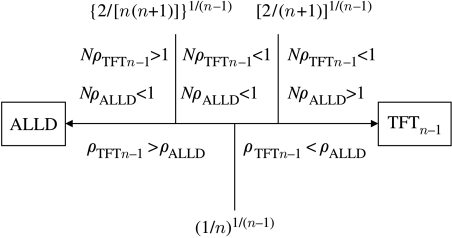Figure 2.
The relationship between the fixation probabilities and the frequency of TFTn−1 at the unstable equilibrium (p*). If (3.5) holds, then , i.e. selection favours TFTn−1 replacing ALLD and opposes ALLD replacing TFTn−1. If (3.6) holds, then , i.e. selection favours ALLD and opposes TFTn−1. If neither (3.5) nor (3.6) is satisfied, then both and NρALLD are less than 1, i.e. selection opposes the fixation of either strategy. We also find that (3.7) is equivalent to . All these relationships hold for large population size. Although ALLD is evolutionarily stable against invasion by TFTn−1 in the deterministic model, in our stochastic model, the probability that a single mutant of TFTn−1 takes over an ALLD population can exceed 1/N.

